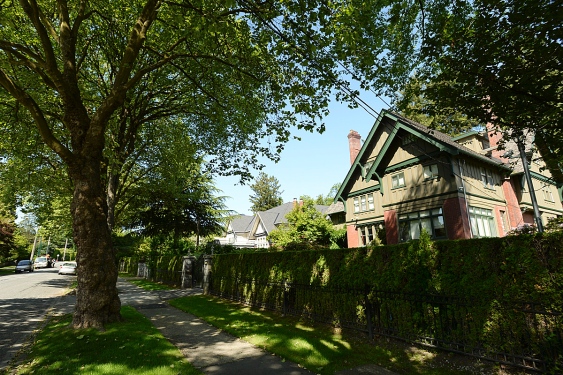Naoibh O’Connor
Van. Courier

The vote to designate First Shaughnessy as a Heritage Conservation Area was unanimous. The decision came following three days of public hearings, which were held in August and earlier this month. Photo Dan Toulgoet
Vancouver city council designated First Shaughnessy as the city’s first-ever Heritage Conservation Area Tuesday morning.
Vision Coun. Heather Deal said she was strongly in favour of the motion.
“I think this will be a neighbourhood that we’ll look back on decades from now and say ‘thank God we did this when we did.’ If we waited another couple of years, we could have seen another dozen or two dozen homes destroyed,” she said.
The vote was unanimous. The decision came following three days of public hearings, which were held in August and earlier this month.
First Shaughnessy sits between 16th and 25th and Oak and East Boulevard. It’s Vancouver’s first CPR-developed subdivision.
In 1982, due to its historical importance, the First Shaughnessy Official Development Plan was enacted to preserve the area’s “pre-1940 estate image and single-family character while allowing change.”
In recent years, heritage activists and the city became concerned about the number of homes being demolished and replaced with modern builds.
In June of 2014, council approved a temporary prohibition on demolishing pre-1940 homes in the First Shaughnessy district so the city could review the area’s official development plan and determine what steps could be taken to conserve heritage property.
In the 18 months leading up to the temporary protection order, the number of inquiries proposing to demolish pre-1940 buildings in First Shaughnessy rose from an average of 0.4 per cent per year to 5 per cent per year, with 19 inquiries active at that time.
During the public hearings, 26 people spoke in favour of First Shaughnessy being designated a Heritage Conservation Area, while 10 spoke in favour but with some concerns such as the proposed blanket moratorium on pre-1940s homes and the impacts to property owners who had existing development permit applications pending. Forty-six people spoke against the HCA designation. Many of those speakers objected to the inclusion of all pre-1940s buildings and requested that their property be exempted, according to the city minutes on the hearings. Others raised concerns about the economic impact the designation would have on their property values. In all, council received 316 letters and emails in support, 372 letters and emails against and five emails dealing with other aspects in relation to the application.
Vision Coun. Geoff Meggs said before the council vote that it’s important to take steps to protect the character and history of Vancouver, and that the motion had broad support in Shaughnessy and the city.
“We heard a lot from people who were opposed to it, but we heard a lot as well from people who worked very, very hard in this process and said this is what they thought would be good for the community and what would be good for heritage protection and acknowledgment in this city. I think it will provide a direction and pattern for how we may want to proceed in other neighbourhoods, although it wouldn’t be a cookie cutter approach because there is only one First Shaughnessy,” he said.
“I think it strikes a balance but it won’t cast the neighbourhood in amber. It won’t freeze life in one spot because there are measures there for people who have very significant heritage values in their homes to do certain kinds of densification — put in laneway houses or separate coach houses or something of that sort. That’s been going on for some time. And, as Coun. Deal has pointed out, where people have no heritage value or it’s been substantially destroyed by previously thoughtless development, then that would be acknowledged and owners can go forward in that regard.”
© 2015 Vancouver Courier

